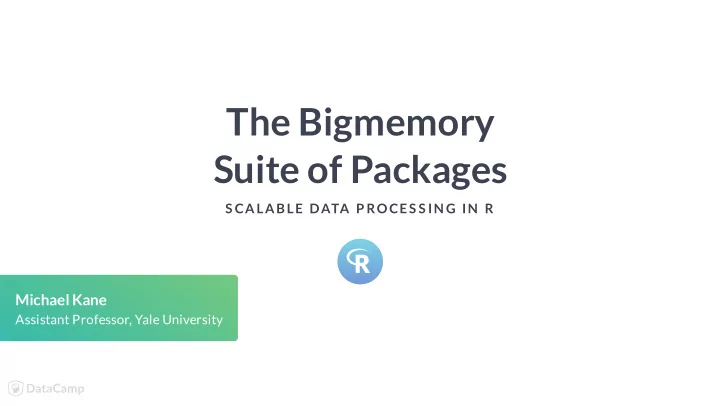

The Bigmemory Suite of Packages S CALABLE DATA P ROCES S IN G IN R Michael Kane Assistant Professor, Yale University
So far .. Import Subset Assign values to big.matrix objects SCALABLE DATA PROCESSING IN R
Associated Packages Tables and summaries biganalytics bigtabulate SCALABLE DATA PROCESSING IN R
Associated Packages Linear algebra bigalgebra SCALABLE DATA PROCESSING IN R
Associated Packages Fit Models bigpca bigFastLM biglasso bigrf SCALABLE DATA PROCESSING IN R
The FHFA's Mortgage Data Set Mortgages that were held or securitized by both Federal National Mortgage Association (Fannie Mae) and Federal Home Loan Mortgage Corporation (Freddie Mac) from 2009-2015 FHFA Mortgage data is available online here We will focus on a random subset of 70000 loans SCALABLE DATA PROCESSING IN R
1st example: using bigtabulate with bigmemory library(bigtabulate) # How many samples do we have per year? bigtable(mort, "year") 2008 2009 2010 2011 2012 2013 2014 2015 8468 11101 8836 7996 10935 10216 5714 6734 # Create nested tables bigtable(mort, c("msa", "year")) 2008 2009 2010 2011 2012 2013 2014 2015 0 1064 1343 998 851 1066 1005 504 564 1 7404 9758 7838 7145 9869 9211 5210 6170 SCALABLE DATA PROCESSING IN R
Let's practice! S CALABLE DATA P ROCES S IN G IN R
Split-Apply-Combine S CALABLE DATA P ROCES S IN G IN R Michael Kane Assistant Professor, Yale University
Split-Apply-Combine Split: split() Apply: Map() Combine: Reduce() SCALABLE DATA PROCESSING IN R
Partition using split() The split() function partitions data First argument is a vector or data.frame to split Second argument is a factor or integer whose values de�ne the partitions SCALABLE DATA PROCESSING IN R
# Get the rows corresponding to each of the years in the mortgage da year_splits <- split(1:nrow(mort), mort[,"year"]) # year_splits is a list class(year_splits) "list" # The years that we've split over names(year_splits) "2008" "2009" "2010" "2011" "2012" "2013" "2014" "2015" # The first few rows corresponding to the year 2010 year_splits[["2010"]][1:10] 1 6 7 10 21 23 24 27 29 38 SCALABLE DATA PROCESSING IN R
Compute using Map() The Map() function processes the partitions First argument is the function to apply to each parition Second argument is the partitions SCALABLE DATA PROCESSING IN R
Compute using Map() col_missing_count <- function(mort) { apply(mort, 2, function(x) sum(x == 9))} # For each of the years count the number of missing values # all columns missing_by_year <- Map( function(x) col_missing_count(mort[x, ]), year_splits) missing_by_year[["2008"]] enterprise record_number msa 0 12 0 # ... SCALABLE DATA PROCESSING IN R
Combine using Reduce() The Reduce() function combines the results for all partitions First argument is the function to combine with Second argument is the partitioned data SCALABLE DATA PROCESSING IN R
# Calculate the total missing values by column Reduce(`+`, missing_by_year) enterprise record_number msa 0 64 0 # ... # Label the rownames with the year mby <- Reduce(rbind, missing_by_year) row.names(mby) <- names(year_splits) mby[1:3, 1:3] enterprise record_number msa 2008 0 12 0 2009 0 8 0 2010 0 10 0 SCALABLE DATA PROCESSING IN R
Let's practice! S CALABLE DATA P ROCES S IN G IN R
Visulize your results using Tidyverse S CALABLE DATA P ROCES S IN G IN R Michael Kane Assistant Professor, Yale University
Missingness by Year library(ggplot2) library(tidyr) library(dplyr) mort %>% bigtable(c("borrower_gender", "year")) %>% as.data.frame() SCALABLE DATA PROCESSING IN R
Missingness by Year library(ggplot2) library(tidyr) library(dplyr) mort %>% bigtable(c("borrower_gender", "year")) %>% as.data.frame() %>% mutate(Category = c("Male", "Female", "Not Provided", "Not Applicable", "Missing")) SCALABLE DATA PROCESSING IN R
Missingness by Year library(ggplot2) library(tidyr) library(dplyr) mort %>% bigtable(c("borrower_gender", "year")) %>% as.data.frame %>% mutate(Category = c("Male", "Female", "Not Provided", "Not Applicable", "Missing")) %>% gather(Year, Count, -Category) SCALABLE DATA PROCESSING IN R
Missingness by Year library(ggplot2) library(tidyr) library(dplyr) mort %>% bigtable(c("borrower_gender", "year")) %>% as.data.frame %>% mutate(Category = c("Male", "Female", "Not Provided", "Not Applicable", "Missing")) %>% gather(Year, Count, -Category) %>% ggplot(aes(x = Year, y = Count, group = Category, color = Category)) + geom_line() SCALABLE DATA PROCESSING IN R
SCALABLE DATA PROCESSING IN R
Let's practice! S CALABLE DATA P ROCES S IN G IN R
Limitations of bigmemory S CALABLE DATA P ROCES S IN G IN R Michael Kane Assistant Professor, Yale University
Where can you use bigmemory? You can use bigmemory when your data are matrices dense numeric Underlying data structures are compatible with low-level linear algebra libraries for fast model �tting If you have different column types, you could try the ff package SCALABLE DATA PROCESSING IN R
Understanding disk access A big.matrix is a data structure designed for random access SCALABLE DATA PROCESSING IN R
Disadvantages of random access Can't add rows or columns to an existing big.matrix object You need to have enough disk space to hold the entire matrix in one big block SCALABLE DATA PROCESSING IN R
Let's practice! S CALABLE DATA P ROCES S IN G IN R
Recommend
More recommend